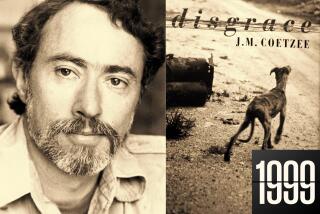Remembering What Others Prefer to Forget : SEASON OF BLOOD: A Rwandan Journey.<i> By Fergal Keane (Viking: $21.95, 198 pp.)</i>
In the book of Genesis, Adam and Eve begot two sons: Abel, a shepherd, and Cain, a farmer. Envious of his brother Abel, whose gift of a firstborn from his flocks found higher regard in God’s eyes than his own gift of crops, “Cain rose up against Abel his brother and he killed him.” Cain was condemned to wander the Earth, protected, oddly, by God’s proclamation that “whoever came upon him would not strike him down.”
In the last 40 years, this bloody paradigm has been repeated periodically in Rwanda. Hutu farmers, traditionally short and dark-skinned, have risen up against Tutsi shepherds, who are typically taller and lighter-skinned. Long envious of the Tutsi’s cattle herds, the Hutus resent the old days of the Tutsi aristocracy and suffer from a lingering sense of inferiority.
After four centuries, hundreds of thousands of Hutus and Tutsis are related through inter-marriage, and the tribes are no longer easy to distinguish physically. But in April 1994, the Hutus began killing their Tutsi brethren at a rate rivaling any genocide in human memory. They were whipped into a frenzy by leaders bent on killing every last Tutsi, a story chillingly retold in “Season of Blood: A Rwandan Journey” by BBC television journalist Fergal Keane.
Today, the Tutsis lead an uneasy government of national reconciliation with groups of moderate Hutus, after triumphing in the bloody civil war. But the specter of continued conflict and more genocide continues to haunt Rwanda, as Keane repeatedly points out.
“Remember the figures,” he pleads, in his compelling, first-hand account of the tragedy. “Never ever forget them: in one hundred days, up to one million people were hacked, shot, strangled, clubbed and burned to death. . . . This is not to ignore the vast numbers who were wounded, raped and terrorized, or the thousands of orphans whom I found clustered around derelict buildings across the country.”
Keane, who has produced a book of brief but carefully considered reportage, history and meditation, arrived in Rwanda about two-thirds of the way through the killing season. The book follows him and his camera crew first into territory captured by Tutsi rebels, past rivers flowing with bloated Tutsis and churches piled high with mutilated Tutsis. Then he enters the shrinking domain of the retreating Hutu killers. Keane’s depiction of the journey is captivating, his history of the conflict lucid and the whole of the book very disturbing.
“Season of Blood” is a descent into hell and succeeds on the strength of its novelistic narrative. The cast of characters--the good soldiers, the children literally dying of sadness, the monks undone by the slaughter at their orphanage, the drunken killers--are all very well drawn. There are passages rich and ironic enough to recall the African travel writing of Graham Greene. Keane’s is the only major book on the Rwandan genocide to have appeared so far, perhaps because the other journalists who were there would prefer to forget what they saw.
“Those of us who spent time in Rwanda to a man can’t remember,” says Aidan Hartley, a reporter seasoned in the African civil wars. “Keane was moved by what he saw. Everyone else was silent or cynical.” Indeed, the author makes you feel what it was like to observe such devastation precisely because he records his own emotional reactions to events as they happen. And throughout his riveting odyssey, he weaves a lucid history of the African conflict:
In 1918, the Treaty of Versailles awarded the former German colony of Ruanda--as it was then known--to Belgium as a League of Nations protectorate. The Belgians chose to administer the territory through the existing Tutsi monarchy. Outnumbered 10 to 1, the Tutsis ruled the Hutus, and the Belgians introduced ethnic identity cards differentiating the two tribes.
In 1959, the Tutsi king died and the Hutu majority, angered by its diminished status, massacred thousands of Tutsis. Many more fled to nearby countries. Three years later, Rwanda gained independence with a Hutu government and launched yet another blood bath that produced a second wave of Tutsi refugees. A third and fourth purge of Tutsis occurred in 1967 and 1973.
The Tutsis fought back in 1990 when Tutsi soldiers--along with refugees from 1959 and their sons and daughters who had grown up in exile--invaded Rwanda from Uganda. They were unlike any other guerrilla army in Africa, highly disciplined, not given to rape and pillage. After six months of fighting, in which French troops helped repulse the Tutsi advance, a cease-fire was signed.
For the next three years, while the Hutu Rwandan government stalled on establishing a multi-party system with the Tutsis, the Rwandan army trained Hutu civilian militia and the government mounted a massive propaganda campaign to convince 6.5 million Hutus that the Tutsis were returning to enslave them. Then, in April 1994, the Hutu president--who had held power for 21 years but succumbed finally to international pressure to democratize--was shot out of the sky just before his jet landed in the Rwandan capital of Kigali. In all likelihood, his own presidential guard fired the rockets, hoping to install a more extremist government. But Hutus blamed the plane crash on the Tutsis, and the hundred days of genocide began.
Across the country, Hutu villagers turned on their Tutsi neighbors, hacking whole families apart with machetes, crushing their skulls with clubs. Tutsis who fled were singled out by their ethnic identity cards, raped and butchered. Moderate Hutus were assassinated.
In June 1994, with the tables turned and millions of Hutu refugees in Tanzania and Zaire, Keane interviewed Hutus who were still hunting Tutsi survivors in the last territories held by the retreating Rwandan army. “They spoke incessantly of the Tutsi plot to reimpose feudalism. . . . The words were old and stale, a script written by the architects of the genocide and repeated endlessly down the line to the most impoverished, illiterate peasant.”
The author blames not only these Hutus but the international community for the scope of the genocide. Although they knew of the senior officers’ genocidal intention, Keane says, the French propped up the Rwandan army. France still harbors those who orchestrated the mass killings, many of whom are wanted by the United Nations tribunal. The United States--by insisting that the U.N. force in Kigali be cut to a mere 250 soldiers and by haggling for higher rental terms for armored vehicles--minimized and delayed U.N. intervention, denying protection to thousands of Tutsis, Keane says. Even the post-apartheid South African government is to blame, he says, for allowing the sale of ammunition to the Rwandan army.
While the Tutsis and moderate Hutus work toward reconciliation in a ravaged Rwanda, Keane points out that perpetrators of the genocide control refugee camps in Zaire and Tanzania. Some of the villains may be brought to justice by the U.N., but hundreds of thousands of Hutu militiamen continue to train and rearm in the camps, humanitarian havens for the killers.
Like Cain, the Hutus are free to wander with blood on their hands--enjoying the dispensation of a world that does not care enough to disarm them. Many in the West might be suffering from compassion fatigue, yet Keane professes an idealism of the “For Whom the Bell Tolls” variety: “We should care because we belong to the same brotherhood of man as the citizens of seemingly remote African countries. Genocidal killing in Africa diminishes all of us.”
More to Read
Sign up for Essential California
The most important California stories and recommendations in your inbox every morning.
You may occasionally receive promotional content from the Los Angeles Times.









